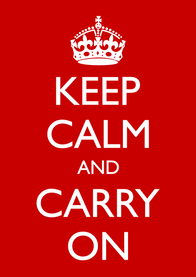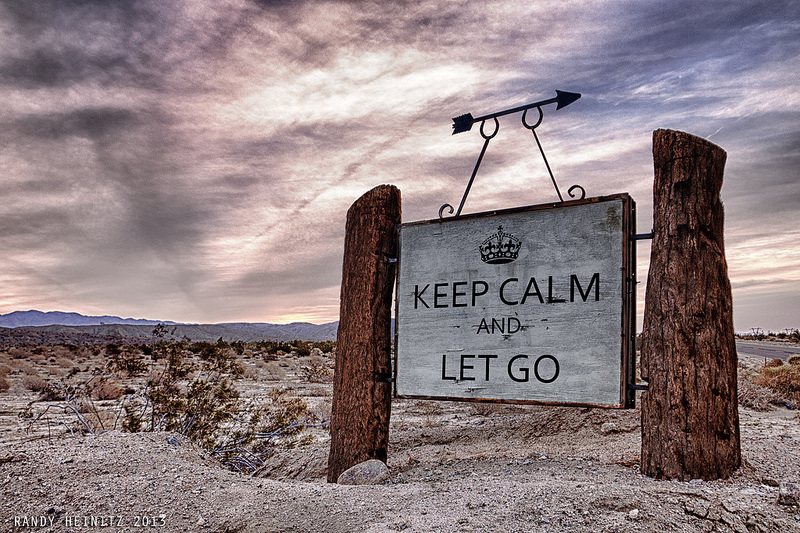|
This very catchy slogan is everywhere now. T-shirts, mugs, posters, internet memes... Keep Calm and Carry On. Very simple, yet profound advice. And in response, lots of alternative versions of the slogan have surfaced, some using humor (Keep Calm and Gangnam Style...yes!), and lots of naysayers challenging it. What is it about this phrase that was first publicized on a poster in Britain during World War II that has us captivated? I'd venture to guess the idea of keeping calm seems like pure gold to most in today's hectic, information-heavy, productivity-obsessed society. The more we race around trying to accomplish tasks, fulfill roles, realize dreams, negotiate relationships, and enjoy ourselves, the more we become frantic, overwhelmed, and feeling like we've met an impossible task of doing it all. No wonder anxiety disorders are diagnosed with such frequency, when the demands of modern life are so intense! No wonder we latch on to catch phrases and anything possible to ease the pace of a busy mind. So in the spirit of keeping calm, here are 5 tips to manage worry, chaos, and general overwhelm. 1. First, recognize what you can and cannot control. There are some things simply out of your reach, and beyond what our actions, thoughts, or feelings will influence. Probably the most common example is mistakenly trying to change other people's behavior, decisions, attitudes, or beliefs when they aren't aligned with your own. Recognize that no matter how much you may want others to change, you simply do not have the power on your own to make that happen. You can be honest about your concerns or express your worries, but that's no guarantee that change in another person will occur. Other examples of things that are out of you control could be work circumstances or immediate financial situations, political dynamics in your community, and historical events. Letting go of worry about things that are out of your control can help loosen the grip of anxiety.
2. Second, learn where stress lodges in your body. Many times it's the neck and shoulders where tension builds up. Sometimes it's in the forehead, abdomen, or hips. It can be anywhere, but be aware that chronic stress and tension does manifest physically. This happens because stress triggers the sympathetic nervous system which kicks in the fight or flight response. This level of hyper-arousal gets stuck in the "ON" position when we don't allow ourselves to learn relaxation techniques and the time to practice them on a regular basis. Scan the body and take note of where you feel constantly tense. 3. Third, re-learn how to breathe. Yes, breathe. You do it automatically, but try it intentionally. Slowing down and deepening your breathing into the belly area will increase relaxation and a sense of calm. Often as schedules become busier and circumstances more distressing, you may start breathing shallow and high in your chest. You may not even know you're doing this, but your body is stressing and tightening in a natural reaction to what your brain perceives as intense outer demands. The good news is that your circumstances most likely don't require fight or flight mode, and as you change your thinking about your situation, you can adjust your breathing.When you're feeling overwhelmed, find a quiet(er) place to go if you can, close your eyes, and breathe 5 intentional breaths. 4. Fourth, take inventory. If you have 10 hours worth of things to fit into 8, then something may need to get nixed off the to-do list. If you have more projects than you can juggle at the same time, then you may need to call someone for help share the work. If you have relationships in your life that create more stress than joy, it may be time to think critically about whether they can improve. If you like things in order, or spend inordinate amounts of time cleaning or organizing, you can consider where other aspects of your life may feel out of control. Taking inventory is like holding up a mirror in front of yourself and your daily routine. When you see the big picture, you can tell what's most important and what you can live without. 5. And fifth, accentuate the positive. Find gratitude for all that is good and right in your life. You can find gratitude for daily events like getting a good night's sleep or enjoying a meal, or when you consider your bigger picture, you may find appreciation for aspects of your family, work, or home that might have gone unnoticed. New advances in brain science have discovered a feature called "neuroplasticity", or flexibility in the brain to absorb and assimilate new ways of thinking throughout the lifespan. So in adulthood, we aren't hard-wired to be a certain way. Positive thinking can actually change your brain and reroute old patterns of personality and behavior that you may have felt stuck with. Challenge yourself to make a small list of 3 or 4 things that are positive in your life every week and keep doing it regularly. So is there hope to keep calm after all? Yes! It's about managing the chaos, not avoiding it. Managing stress can be hard, and if you need help, support is available. Ask a loved one or professional to help you work through things. Individual counseling at Flourish is one such source of support. Comments are closed.
|
AuthorKambria Kennedy-Dominguez, LPC-S |
Phone: 972.755.9120 | Fax: 214.723.5345
533 W. 12th Street Dallas, TX 75208
Privacy Policy Good Faith Estimate
©Flourish Counseling and Consultation PLLC 2024
533 W. 12th Street Dallas, TX 75208
Privacy Policy Good Faith Estimate
©Flourish Counseling and Consultation PLLC 2024





 RSS Feed
RSS Feed
